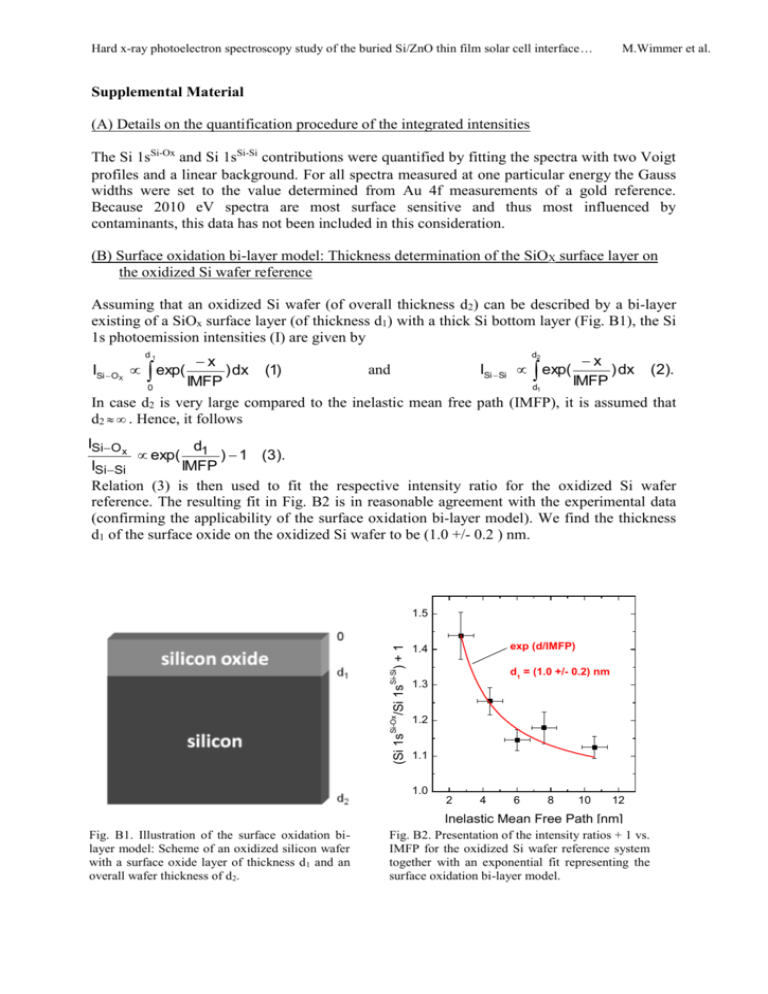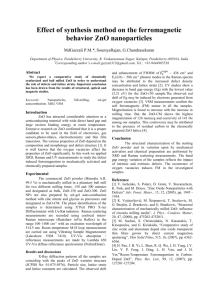Supplemental Material
advertisement

Hard x-ray photoelectron spectroscopy study of the buried Si/ZnO thin film solar cell interface… M.Wimmer et al. Supplemental Material (A) Details on the quantification procedure of the integrated intensities The Si 1sSi-Ox and Si 1sSi-Si contributions were quantified by fitting the spectra with two Voigt profiles and a linear background. For all spectra measured at one particular energythe Gauss widths were set to the value determined from Au 4f measurements of a gold reference. Because 2010 eV spectra are most surface sensitive and thus most influenced by contaminants, this data has not been included in this consideration. (B) Surface oxidation bi-layer model: Thickness determination of the SiOX surface layer on the oxidized Si wafer reference Assuming that an oxidized Si wafer (of overall thickness d2) can be described by a bi-layer existing of a SiOx surface layer (of thickness d1) with a thick Si bottom layer (Fig. B1), the Si 1s photoemission intensities (I) are given by 2 x x and ISi Si exp( ) dx (2). ISi OX exp( ) dx (1) IMFP IMFP d1 0 In case d2 is very large compared to the inelastic mean free path (IMFP), it is assumed that d2 . Hence, it follows d d1 ISiO x d1 ) 1 (3). ISiSi IMFP Relation (3) is then used to fit the respective intensity ratio for the oxidized Si wafer reference. The resulting fit in Fig. B2 is in reasonable agreement with the experimental data (confirming the applicability of the surface oxidation bi-layer model). We find the thickness d1 of the surface oxide on the oxidized Si wafer to be (1.0 +/- 0.2 ) nm. exp( (Si 1s Si-Ox /Si 1s Si-Si )+1 1.5 d1 = (1.0 +/- 0.2) nm 1.3 1.2 1.1 1.0 Fig. B1. Illustration of the surface oxidation bilayer model: Scheme of an oxidized silicon wafer with a surface oxide layer of thickness d1 and an overall wafer thickness of d2. exp (d/IMFP) 1.4 2 4 6 8 10 12 Inelastic Mean Free Path [nm] Fig. B2. Presentation of the intensity ratios + 1 vs. IMFP for the oxidized Si wafer reference system together with an exponential fit representing the surface oxidation bi-layer model. Hard x-ray photoelectron spectroscopy study of the buried Si/ZnO thin film solar cell interface… M.Wimmer et al. (C) Evaluation of the influence of the finite Si thin-film thickness for the quantification and interpretation of the Si 1sSi-Ox/Si 1sSi-Si intensity ratio The reason to use the normalized Si 1sSi-Ox/Si 1sSi-Si intensity ratio for our quantitative consideration is the simplification presented by Eq. (3). This simplification is in fact an estimation which is good for Si layer thicknesses >> IMFP. If Si layers are considered with an in this sense finite thickness or if the excitation energy (and thus IMFP) is significantly increased, this estimation starts to fail. In the following this effect is investigated assuming a 12 nm silicon layer ( total thickness, “dfilm”) on top of the ZnO with a surface oxide layer of 0.6 nm (“dSi-Ox”) as found for small IMFPs for the as-deposited and heated Si/ZnO samples of the in-situ experiment (see Fig. 2b). Using the following integrals ISi O x dSi Ox 0 x exp( ) dx IMFP ISiSi and ( 4) dfilm dSi Ox exp( x ) dx IMFP (5 ) , we compute the intensity ratios ISi-Ox /ISi-Si for the assumed SiOX/Si/ZnO model layer stack normalized to the respective intensity ratios of the wafer [dSi-Ox (Si wafer) = 1 nm] for the different IMFP values and compare it to the experimental data measured for the as-deposited and heated Si/ZnO samples in Fig. C1. We find that the behavior of the computed intensity ratio agrees reasonably well with the experimental data of the as-deposited Si/ZnO sample. Thus besides an interface oxidation taking place already upon deposition also the finite Si layer thickness effect itself might explain the slight increase of the normalized intensity ratio with increasing IMFPs observed for the as-deposited sample. However, it cannot explain the significantly more pronounced intensity ratio increase observed for high IMFPs for the heated Si/ZnO sample. Model: SiOX (0.6 nm)/Si (11.4 nm)/ZnO 1.5 1.0 X Normalized Intensity Ratio Si-O Si-Si (Si 1s / Si 1s ) as-deposited heated 0.5 2 4 6 8 10 12 Inelastic Mean Free Path [nm] Fig. C1. Measured Si 1sSi-Ox/Si 1sSi-Si intensity ratios of the Si/ZnO layer stack normalized to the respective ratios of an oxidized Si wafer reference for the in-situ experiment (as-deposited sample - black solid symbols; heated sample - red open symbols) compared to ratios as computed for a SiOX (0.6 nm)/Si (11.4 nm)/ZnO model layer stack (blue open symbols). (D) Transfer of energy reference positions and chemical speciation Because there is limited validated reference data available for the Si 1s photoemission line, reference data from the well-investigated Si 2p line was transferred to the Si 1s photoemission Hard x-ray photoelectron spectroscopy study of the buried Si/ZnO thin film solar cell interface… M.Wimmer et al. energy range. For that, it was assumed that the high-binding energy contribution of the investigated oxidized Si wafer reference can be attributed to SiO2. Its binding energy difference to the Si-Si contribution of about 4.7 eV is slightly higher than the energy difference between Si 2pSi-O2 and Si 2pSi-Si. Thus, we transfer the reference Si 2p binding energy positions of the sub-oxides1,2 in relation to the energy difference (“”) defined by the Si-Si (Si0) and Si-O2 (Si4+) contributions see Table I. Table I: Si 2p Binding energy reference positions for different Si sub-oxides as found in Refs. [1,2] and respective transferred binding energy ranges for the Si 1s photoemission line. Si 2p Kim et al.1 Aarnink et al.2 Si 1s (transferred) (Si4+,Si0)/eV 4.24 3.8 4.5-4.9 (Si3+,Si0)/eV 2.48 2.5 2.7-3.1 (Si2+,Si0)/eV 1.75 1.7 1.9-2.1 (Si1+,Si0)/eV 0.95 1 1.1-1.2 To identify the oxygen species the energetic position of the experimental O 1s HAXPES line was compared to binding energy data for different chemical species determined by conventional photoemission measurements3-8. For that, it was assumed that the low-binding energy O 1s contribution which can be observed in Fig. 3b can be attributed to ZnO. Thus, the reference binding energy ranges (ZnO: 530.1-531.0 eV, Zn2SiO4: 531.4-531.8 eV, SiOX/SiO2: 532.1-532.8 eV) are given relative to the center of the ZnO reference binding energy range in Fig. 3b. Table II: O 1s Binding energy reference position for different oxygen species as found in Refs. [3-8]. The italic binding energy values are estimated from the spectra in the corresponding reference. O 1s Meier et al.3 Lin et al.4 Chen et al.5 Futsuhara et al.6 Chao et al.7 Böhmer et al.8 rel. O 1s position 1 ZnO/eV 531.0 530.4 530.15 530.1 530.8 +/- 0.45 Zn2SiO4/eV 531.8 531.4 0.85-1.25 SiOX/eV SiO2/eV 532.8 532.5 532.1-532.3 532.4 532.5 1.55-2.25 K. J. Kim, K. T. Park, and J. W. Lee, Thin Solid Films 500, 356 (2006). W. A. M. Aarnink, A. Weishaupt, and A. van Silfhout, Appl. Surf. Sci. 45, 37 (1990). 3 U. Meier and C. Pettenkofer, Appl. Surf. Sci. 252, 1139 (2005). 4 C. M. Lin, Y. Z. Tsai, and J.S. Chen, Thin Solid Films 515, 7994 (2007). 5 M. Chen, X. Wang, Y. H. Yu, Z. L. Pei, X. D. Bai, C. Sun, R. F. Huang, and L.S. Wen, Appl. Surf. Sci. 158, 134 (2000). 6 M. Futsuhara, K. Yoshioka, and O. Takai, Thin Solid Films 322, 274 (1998). 7 S. S. Chao, Y. Takagi, G. Lucovsky, P. Pai, R. C. Custer, J. E. Tyler, and J. E. Keem, Appl. Surf. Sci. 26, 575 (1986). 8 E. Böhmer, F. Siebke, and H. Wagner, Fresenius, J. Anal. Chem. 358, 210 (1997). 2





